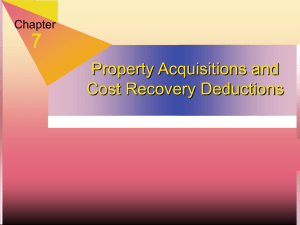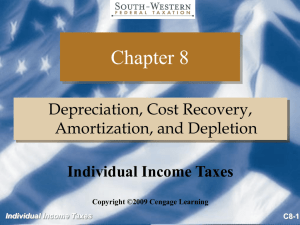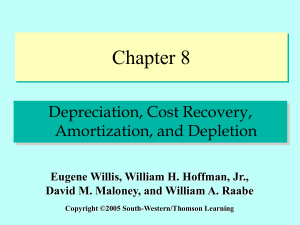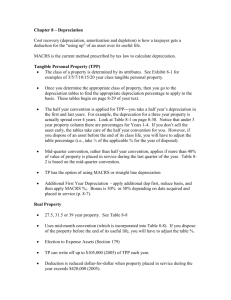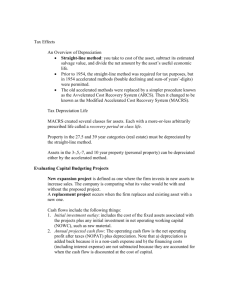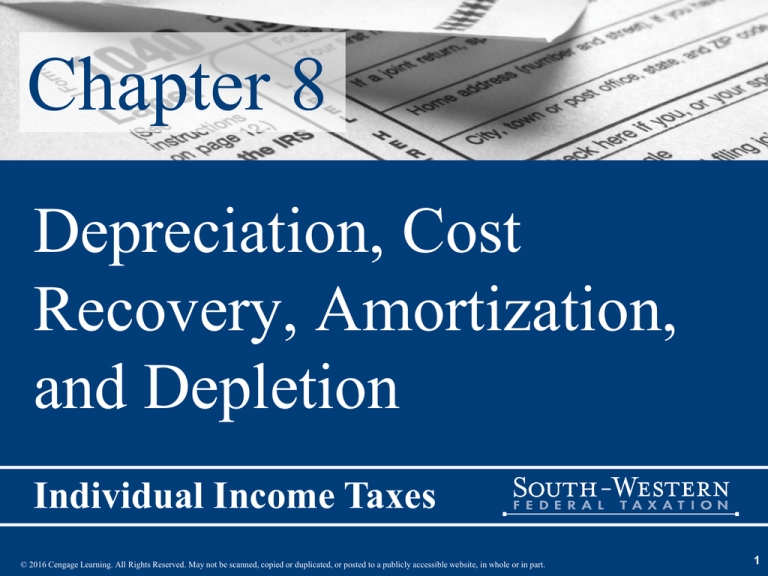
Chapter 8
Depreciation, Cost
Recovery, Amortization,
and Depletion
Individual Income Taxes
© 2016 Cengage Learning. All Rights Reserved. May not be scanned, copied or duplicated, or posted to a publicly accessible website, in whole or in part.
1
The Big Picture (slide 1 of 2)
• Dr. Cliff Payne purchases and places in service in his dental
practice the following fixed assets during the current year:
Office furniture and fixtures
Computers and peripheral equipment
Dental equipment
$ 70,000
67,085
475,000
• Using his financial reporting system, he concludes that the
depreciation expense on Schedule C of Form 1040 is $91,298.
Office furniture and fixtures ($70,000 X 14.29%)
$10,003
Computers and peripheral equipment ($67,085 X 20%) 13,417
Dental equipment ($475,000 X 14.29%)
67,878
$91,298
2
The Big Picture (slide 2 of 2)
• In addition, during the current year, Dr. Payne
purchased another personal residence for $300,000
– He converts his original residence to rental property.
• He also purchased a condo for $170,000 near his
office that he is going to rent.
• Has Dr. Payne correctly calculated the depreciation
expense for his dental practice?
– Will he be able to deduct any depreciation expense for his
rental properties?
• Read the chapter and formulate your response.
3
Cost Recovery
• Recovery of the cost of business or incomeproducing assets is through:
– Cost recovery or depreciation: tangible assets
– Amortization: intangible assets
– Depletion: natural resources
4
Nature of Property
• Property includes both realty (real property) and
personalty (personal property)
– Realty generally includes land and buildings permanently
affixed to the land
– Personalty is defined as any asset that is not realty
• Personalty includes furniture, machinery, equipment, and many
other types of assets
• Personalty (or personal property) should not be
confused with personal use property
– Personal use property is any property (realty or personalty)
that is held for personal use rather than for use in a trade or
business or an income-producing activity
• Cost recovery deductions are not allowed for personal use assets
5
General Considerations
(slide 1 of 3)
• Basis in an asset is reduced by the amount of cost
recovery that is allowed and by not less than the
allowable amount
– Allowed cost recovery is cost recovery actually taken
– Allowable cost recovery is amount that could have been
taken under the applicable cost recovery method
• If no cost recovery is claimed on property
– The basis of the property must still be reduced by the
amount that should have been deducted
• i.e., The allowable cost recovery
6
General Considerations
(slide 2 of 3)
• If personal use assets are converted to business
or income-producing use
– Basis for cost recovery and for loss is lower of
• Adjusted basis or
• Fair market value at time property was converted
– Losses that occurred prior to conversion can not be
recognized for tax purposes through cost recovery
7
General Considerations
(slide 3 of 3)
• MACRS applies to:
– Assets used in a trade or business or for the
production of income
– Assets subject to wear and tear, obsolescence, etc.
– Assets that have a determinable useful life or
decline in value on a predictable basis
– Assets that are tangible personalty or realty
8
The Big Picture - Example 2
Cost Recovery Basis for Personal Use Assets
Converted to Business Use
• Return to the facts of The Big Picture p. 8-1.
• Five years ago Dr. Payne purchased his personal residence for
$250,000.
– This year Dr. Payne found a larger home that he acquired for his
personal residence.
– Unfortunately he cannot sell his original residence and recover his
purchase price of $250,000.
• The residence was appraised at $180,000.
• Instead of continuing to try to sell the original residence, Dr.
Payne converted it to rental property.
– The basis for cost recovery of the rental property is $180,000 because
the fair market value is less than the adjusted basis.
– The $70,000 decline in value is deemed to be personal (since it
occurred while the property was held for personal use by Dr. Payne)
and therefore nondeductible.
9
MACRS-Personalty
• MACRS characteristics:
MACRS Personalty
Statutory lives:
Method:
Convention:
3, 5, 7, 10 yrs
200% DB
Half Yr
or
.
15, 20 yrs
150% DB
Mid-Quarter
DB = declining balance with switch to straight-line
Straight-line depreciation may be elected
10
Half-Year Convention
• General rule for personalty
• Assets treated as if placed in service (or
disposed of) in the middle of taxable year
regardless of when actually placed in service
(or disposed of)
11
Example: Half-Year Convention
• Purchased and placed an asset in service on
March 15 (Tax year end is December 31)
– Treated as placed in service June 30
– Six months cost recovery in year 1 (and year
disposed of, if within recovery period)
12
Mid-Quarter Convention
• Applies when more than 40% of personalty is
placed in service during last quarter of year
• Assets treated as if placed into service (or
disposed of) in the middle of the quarter in
which they were actually placed in service (or
disposed of)
13
Example: Mid-Quarter Convention
• Business with 12/31 year end purchased and placed in
service the following used 5-year class assets:
• Asset 1: on 3/28 for $50,000, and
• Asset 2: on 12/28 for $100,000
• More than 40% placed in service in last quarter;
therefore, mid-quarter convention used:
• Asset 1: $50,000 × 35% (Exhibit 8.5) = $17,500
• Asset 2: $100,000 × .05 (Exhibit 8.5) = $5,000
14
The Big Picture - Example 7
Mid-Quarter Convention
15
MACRS-Realty
(slide 1 of 2)
• MACRS characteristics:
MACRS Realty
Residential Rental Nonresid. Realty
Statutory lives:
27.5 yrs
31.5 yrs or 39 yrs
Method:
Straight-line
Convention:
Mid-month
• Residential rental real estate
– Includes property where 80% or more of gross rental
revenues are from nontransient dwelling units
• e.g., Apartment building
– Hotels, motels, and similar establishments are not
residential rental property
16
MACRS-Realty
(slide 2 of 2)
• Mid-month Convention
– Property placed in service at any time during a
month is treated as if it was placed in service in the
middle of the month
– Example: Business building placed in service April
25 is treated as placed in service April 15
17
Optional Straight-line Election
• May elect straight-line rather than accelerated
depreciation on personalty placed in service
during year
– Use the class life of the asset for the recovery
period
– Use half-year or mid-quarter convention as
applicable
– Election is made annually by class of property
18
The Big Picture - Example 11
Straight-Line Election
19
The Big Picture - Example 12
Straight-Line Election
20
Additional First-Year Depreciation
(slide 1 of 2)
• Additional first-year depreciation has been
allowed for several years
• Although the provision was written to expire at
the end of 2013, Congress may extend this
provision during 2015
21
Additional First-Year Depreciation
(slide 2 of 2)
• Additional first-year depreciation allows an
additional 50% of cost recovery in year asset is
placed in service
• Qualified property includes most types of new
property other than buildings
– Property that is used but new to the taxpayer does
not qualify
22
Example: Additional
First-Year Depreciation
Maple Company acquires a 5-year class asset on
April 25, 2015, for $20,000. Maple’s cost recovery
deduction for 2015 is computed as follows:
50% additional first-year
depreciation ($20,000 X .50)
MACRS cost recovery
[($20,000 - $10,000) X .20 (Exhibit 8.4)]
Total cost recovery
$10,000
2,000
$12,000
23
The Big Picture - Example 15
MACRS With Additional First-Year
Depreciation
24
Election to Expense Assets
-Section 179 (slide 1 of 5)
• General rules
– Can elect to immediately expense up to $500,000
of business tangible personalty placed in service in
2015
– Cannot use § 179 for most realty or production of
income property
25
Election to Expense Assets
-Section 179 (slide 2 of 5)
• Section 179 general rules
– Amount expensed reduces depreciable basis
– Any elected § 179 expense is taken before
additional first-year depreciation is computed
• The base for calculating the standard MACRS
deduction is net of the § 179 expense and the additional
first-year depreciation (50% in 2015)
26
Election to Expense Assets
-Section 179 (slide 3 of 5)
• Annual limitations:
– Expense limitation ($500,000 for 2015) is reduced
by amount of § 179 property placed in service
during year that exceeds $2,000,000 in 2015
• Example: In 2015, taxpayer placed in service
$2,015,000 of § 179 property.
– The § 179 expense limit is reduced to $485,000
• [$500,000 – ($2,015,000 – $2,000,000)]
27
Election to Expense Assets
-Section 179 (slide 4 of 5)
• Annual limitations:
– Election to expense cannot exceed taxable income (before
§ 179) of taxpayer’s trades or businesses
• Any amount expensed under § 179 over taxable income limitation
may be carried over to subsequent year(s)
• Amount carried over still reduces basis currently
– The § 179 amount eligible for expensing in a carryforward
year is limited to the lesser of
• The statutory dollar amount ($500,000 in 2015) reduced by the cost
of § 179 property placed in service in excess of $2,000,000 (in
2015) in the carryforward year, or
• The business income limitation in the carryforward year.
28
Election to Expense Assets
-Section 179 (slide 5 of 5)
Example 17:
29
Listed Property (slide 1 of 4)
• There can be substantial limits on cost
recovery of assets considered listed property
• Listed property includes the following:
– Passenger automobile
– Other property used as a means of transportation
– Property used for entertainment, recreation, or
amusement
– Computer or peripheral equipment
– Cellular telephone
30
Listed Property (slide 2 of 4)
• To be considered as predominantly used for
business, business use must exceed 50%
• Use of asset for production of income is not considered
in this 50% test
• However, both business and production of income use
percentages are used to compute cost recovery
31
Listed Property (slide 3 of 4)
• To be considered as predominantly used for
business (cont’d)
• If 50% test is met, then allowed to use statutory
percentage method of cost recovery with some
limitations
32
Listed Property (slide 4 of 4)
• If asset is not used predominantly for business
i.e., business use does not exceed 50%
– Must use straight-line method
– If business use falls to 50% or lower after year
property is placed in service, must recapture excess
cost recovery
33
Passenger Auto Cost
Recovery Limits (slide 1 of 7)
For autos placed in service in 2014, cost recovery limits are:
Year
Recovery Limitation
1
$3,160
2
5,100
3
3,050
Succeeding years until
the cost is recovered
1,875
• If a passenger auto used predominantly for
business qualifies for additional first-year
depreciation
– First-year recovery limitation is increased by $8,000
• Limit increases from $3,160 to $11,160 ($3,160 + $8,000).
34
Passenger Auto Cost
Recovery Limits (slide 2 of 7)
• Limits are for 100% business use
– Must reduce limits by percentage of personal use
• Limit in the first year includes any amount the
taxpayer elects to expense under § 179
35
Passenger Auto Cost
Recovery Limits (slide 3 of 7)
Example: Taxpayer acquired an auto in 2014
for $30,000, used it 80% for business, and
elects not to take additional first-year
depreciation.
2014 cost recovery allowance:
($30,000 × 20%) × 80%
$4,800
But deduction is limited to
× Business use %
Cost recovery allowance
$3,160
× 80%
$2,528
36
Passenger Auto Cost
Recovery Limits (slide 4 of 7)
• Limit on § 179 deduction
– For certain vehicles not subject to the statutory
dollar limits imposed on passenger automobiles the
§ 179 deduction is limited to $25,000
• The limit applies to sport utility vehicles with an
unloaded GVW rating of more than 6,000 pounds and
not more than 14,000 pounds
37
Passenger Auto Cost
Recovery Limits (slide 5 of 7)
• Listed property that fails the >50% business usage
test in year property is placed in service must be
recovered using the straight-line method
– Such property does not qualify for additional first-year
depreciation
• If the >50% business usage test is failed in a year
after the property is placed in service, straight-line
method must be used for remainder of property’s life
– Cost recovery of passenger auto under straight-line listed
property rule still subject to annual limits
38
Passenger Auto Cost
Recovery Limits (slide 6 of 7)
• Change from predominantly business use
– If the business use percentage falls to 50% or
lower after the year the property is placed in
service, the property is subject to cost recovery
recapture
– The amount recaptured as ordinary income is the
excess cost recovery
• Excess cost recovery is the excess of the cost recovery
deductions taken in prior years using the statutory
percentage method over the amount that would have
been allowed if the straight-line method had been used
39
Passenger Auto Cost
Recovery Limits (slide 7 of 7)
• Leased autos subject to inclusion amount rule
– Using IRS tables, taxpayer has gross income equal
to each lease year’s inclusion amount
– Purpose is to prevent avoidance of cost recovery
dollar limits applicable to purchased autos by
leasing autos
40
Farm Property
(slide 1 of 2)
• Generally, for farm assets use:
– MACRS 150% declining-balance method for
personalty
• MACRS straight-line method is required for any tree or
vine bearing fruits or nuts
– Straight line method over the normal periods (27.5
years and 39 years) for real property
– If the election is made to not have the uniform
capitalization rules apply, alternative depreciation
system (ADS) straight-line method must be used
41
Farm Property
(slide 2 of 2)
42
Alternative Depreciation
System (ADS) (slide 1 of 2)
• ADS is an alternative depreciation system that
is used in calculating depreciation for:
– Alternative minimum tax (AMT)
– Assets used predominantly outside the U.S.
– Property owned by the taxpayer and leased to tax
exempt entities
– Earnings and profits
43
Alternative Depreciation
System (ADS) (slide 2 of 2)
• Generally, use straight-line recovery without
regard to salvage value
– For AMT, 150% declining balance is allowed for
personalty
– Half-year, mid-quarter, and mid-month
conventions still apply
44
Amortization (slide 1 of 2)
• Can claim amortization deduction on § 197
intangibles
– Use straight-line recovery over 15 years (180
months) beginning in month intangible is acquired
• Section 197 intangibles include acquired
goodwill, going-concern value, trademarks,
trade names, etc.
45
Amortization (slide 2 of 2)
• Startup expenditures are also partially amortizable
under § 195
– Treatment is available only by election
• Allows the taxpayer to deduct the lesser of:
– The amount of startup expenditures, or
– $5,000, reduced by the amount startup expenditures exceed
$50,000
– Any amounts not deducted may be amortized ratably over
180-months beginning in month trade or business begins
46
Depletion
(slide 1 of 4)
• Two methods of natural resource depletion
– Cost: determined by using the adjusted basis of the
resource and allocating over the recoverable units
– Percentage: determined using percentage provided
in Code and multiplying by gross income from
resource sales
47
Depletion
(slide 2 of 4)
• Cost depletion
– Depletion is computed on a per unit basis
– Per unit amount is determined by dividing the
basis of the resource by the estimated recoverable
units of resource
• Number of units sold in year × per unit depletion =
depletion for year
– Total depletion can not exceed total cost of the
property
48
Depletion
(slide 3 of 4)
• Percentage depletion
– Depletion is computed by using the statutory
percentage rate for the type of resource
– Rate is applied to the gross income from the
property
49
Depletion
(slide 4 of 4)
• Percentage depletion
– Percentage depletion cannot exceed 50% of the
taxable income (before depletion) from the
property
– Percentage depletion reduces basis in property
– However, total percentage depletion may exceed
the total cost of the property
• Example: Property with zero basis but still generating
income
50
Intangible Drilling Costs
(IDC)
• Intangible drilling costs include
– Costs for making the property ready for drilling
– Costs of drilling the hole
• Treatment of IDC
– Expense in the year incurred, or
– Capitalize and write off through depletion
• It is generally advantageous to write off IDC
immediately
51
The Big Picture - Example 41
Tax Planning
•
Return to the facts of The Big Picture p. 8-1.
• In January 2014, Dr. Payne purchased residential rental property for
$170,000 ($20,000 allocated to the land, $150,000 to the building).
– He made a down payment of $25,000 and assumed the seller’s mortgage for the
balance.
– Monthly payments of $1,000 are required and are applied toward interest,
taxes, insurance, and principal.
• Since the property was already occupied, Dr. Payne continued to receive
rent of $1,200 per month from the tenant.
• Assume any losses generated by the property are currently deductible and
he is in the 28% tax bracket.
• During 2015, Dr. Payne’s expenses were as follows:
Interest
$10,000
Taxes
800
Insurance
1,000
Repairs and maintenance
2,200
Depreciation ($150,000 X .03636)
5,454
Total
$19,454
52
The Big Picture - Example 41
Tax Planning
• The deductible loss from the rental property is computed as follows:
Rent income ($1,200 X 12 months)
Less expenses (see above)
Net loss
$ 14,400
(19,454)
($ 5,054)
• But what is Dr. Payne’s overall position for the year when the tax benefit of
the loss is taken into account?
• Considering just the cash intake and outlay, it is summarized below:
Intake—
Rent income
Tax savings [28% (income tax bracket) X $5,054
(loss from the property)]
Net Intake
Outlay—
Mortgage payments ($1,000 X 12 months)
Repairs and maintenance
Net Outlay
Net cash benefit
$14,400
1,415
$ 15,815
12,000
2,200
(14,200)
$ 1,615
53
Refocus On The Big Picture
• Evidently, Dr. Payne’s accounting system uses MACRS
because $91,298 of depreciation is the correct amount.
– The computers and peripheral equipment are 5-year property.
– The furniture and fixtures and the dental equip. are 7-year property.
• Based on the IRS tables, the following percentages are used to
calculate first year depreciation expense:
5-year property
7-year property
20.00%
14.29%
• Dr. Payne will also be able to deduct depreciation on the house
he converted from personal use to rental use and on the rental
house that he purchased.
54
If you have any comments or suggestions concerning this
PowerPoint Presentation for South-Western Federal
Taxation, please contact:
Dr. Donald R. Trippeer, CPA
trippedr@oneonta.edu
SUNY Oneonta
© 2016 Cengage Learning. All Rights Reserved. May not be scanned, copied or duplicated, or posted to a publicly accessible website, in whole or in part.
55


